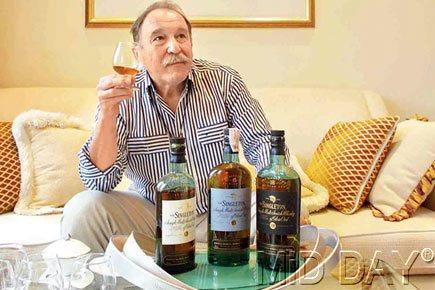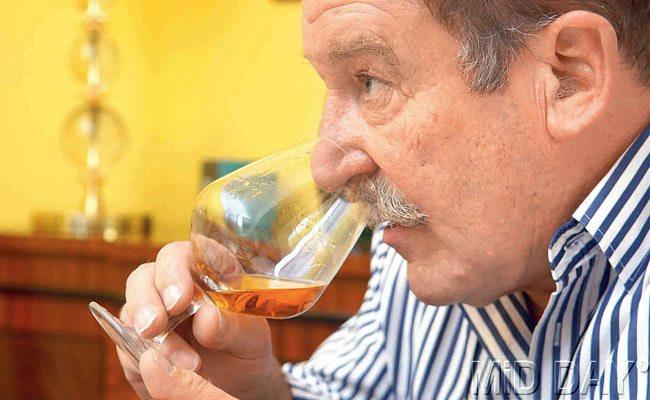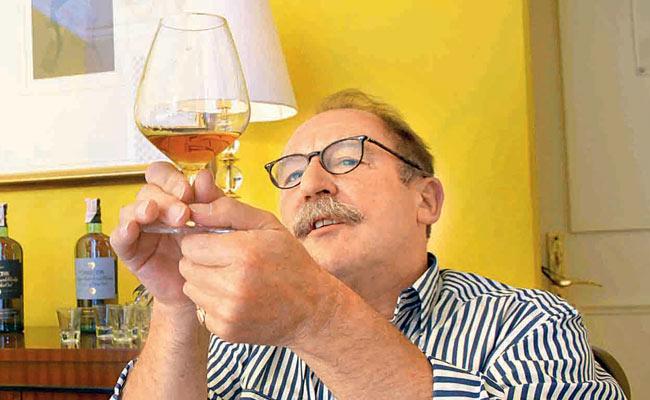Whiskey expert Charlie Maclean takes Phorum Dalal through the high(land)s and low(land)s of Scotland’s whiskey history and shows her how to appreciate single malts

Charlie Maclean, a 63-year-old whiskey expert who was in the country for the annual industry awards of a whiskey magazine held in Bangalore yesterday, welcomed us with a wide grin that hid behind a curly moustache at the Presidential suite of Taj Mahal Palace Hotel, Colaba.
Replete with squeaky-clean glasses, a plate of fruitcake and bottles shining with amber-coloured liquid, the table was laid out for a single-malt whiskey appreciation session.
ADVERTISEMENT

Whiskey expert Charlie Maclean at the Taj Mahal Palace Hotel in Colaba
Pleasantries done, we got down to business. “Whiskeys are of two types — one made of barley and the other of grains such as corn, maize and wheat. Malt whiskey is made from malted barley in copper pot stills, by a batch process. A ‘single’ malt whiskey is the product of an individual distillery whereas ‘vatted’ or ‘blended’ whiskey is a mix of makes from two or more distilleries,” said Maclean. He added that malted barley, hot water and yeast is mixed and distilled to get a sparkling white liquid. This is then put in the cask to mature for 12, 15 or 18 years.
Whiskey appreciation
There are two ways to go about a tasting. An objective tasting relies on analytical deductions, and keeps a tight control over language. “I follow a more subjective approach, also known as Hedonic, which encourages a more personal experience and allows you to make comparisons to foods, drinks, aromas and memories,” he added.
 He studies the legs or tears that trickle down the glass on swirling it. Pics/Atul Kamble
He studies the legs or tears that trickle down the glass on swirling it. Pics/Atul Kamble
“You may enjoy a drink as you like, but use the correct glassware to study it. The snifter glass, which has a short stem, a wide bottom and a tapered mouth is perfect to swirl the drink and take in the fullness of the flavour and fragrance,” explained Maclean, as he poured Singleton of Glen Ord 12 Year Old into two glasses.
Passing the glass to me, he explained that one should not add ice while tasting. “But it’s good to add water as it brings out the whiskey’s aroma,” he added.
I followed his gestures as he elegantly picked the glass, and tilted it to appreciate the colour. “The dark, amber colour comes from the European oak cask. The whiskies, which have a lighter, golden colour have been matured in American oak casks. While whiskies matured in European cask are woody and dry, American casks give a sweeter, floral flavour,” he elaborated.

The olfactory glands play a major role in deciphering the flavour of a whiskey
“Observe the legs or the tears that trickle down the glass on swirling it. The thicker and slower legs indicate an oily-creamy whiskey, which usually has a great texture,” he said, adding that skinny legs are a sign of lighter whiskey.
Following Maclean’s instructions, I drew a wheel of taste and aroma diagram, dividing a circle equally into six categories — winey, cereal, floral, fruity, peaty (smokey and medicinal) and woody — on my notepad. We let the liquid spread on the tongue for a few seconds before we gulped it down. “This one is sweet, with a faint acidity that lingers. It tastes of baked apples,” he said, as we moved on to repeat the process with Singleton of Glen Ord 18 Year Old. This time, I deduced the results. “Waxy, floral, spicy,” I announced, as he nodded in agreement. “No one is fully correct. The part of the brain that manages the olfactory gland is right behind the nose, which leads to the limbic system, also responsible for long-term memory. Thus, what we smell connects us to our memories,” he concluded.
The geography of scotch
Since the 1880s, blenders have identified the varieties of whiskey coming from different parts of Scotland. The division in the 1780s was between whiskeys made in the Lowland and Highland regions. Then the whiskies made in Campbeltown and Islay were discerned to be different, and Speyside got a distinct recognition, too. With the growth of interest in single malts since 1980s, Highland whiskeys have been sub-divided into Northern, Western, Eastern, Southern and Islands makes.
 Subscribe today by clicking the link and stay updated with the latest news!" Click here!
Subscribe today by clicking the link and stay updated with the latest news!" Click here!







